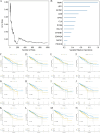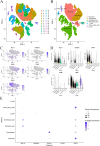Biological function and potential application of PANoptosis-related genes in colorectal carcinogenesis
- PMID: 39237645
- PMCID: PMC11377449
- DOI: 10.1038/s41598-024-71625-7
Biological function and potential application of PANoptosis-related genes in colorectal carcinogenesis
Abstract
PANoptosis induces programmed cell death (PCD) through extensive crosstalk and is associated with development of cancer. However, the functional mechanisms, clinical significance, and potential applications of PANoptosis-related genes (PRGs) in colorectal cancer (CRC) have not been fully elucidated. Functional enrichment of key PRGs was analyzed based on databases, and relationships between key PRGs and the immune microenvironment, immune cell infiltration, chemotherapy drug sensitivity, tumor progression genes, single-cell cellular subgroups, signal transduction pathways, transcription factor regulation, and miRNA regulatory networks were systematically explored. This study identified 5 key PRGs associated with CRC: BCL10, CDKN2A, DAPK1, PYGM and TIMP1. Then, RT-PCR was used to verify expression of these genes in CRC cells and tissues. Clinical significance and prognostic value of key genes were further verified by multiple datasets. Analyses of the immune microenvironment, immune cell infiltration, chemotherapy drug sensitivity, tumor progression genes, single-cell cellular subgroups, and signal transduction pathways suggest a close relationship between these key genes and development of CRC. In addition, a novel prognostic nomogram model for CRC was successfully constructed by combining important clinical indicators and the key genes. In conclusion, our findings offer new insights for understanding the pathogenesis of CRC, predicting CRC prognosis, and identifying multiple therapeutic targets for future CRC therapy.
Keywords: Chemotherapy drug sensitivity; Colorectal cancer; Immune microenvironment; Nomogram; PANoptosis; Prognosis.
© 2024. The Author(s).
Conflict of interest statement
The authors declare no competing interests.
Figures








Similar articles
-
Construction and Validation of Novel Ferroptosis-related Risk Score Signature and Prognostic Prediction Nomogram for Patients with Colorectal Cancer.Int J Med Sci. 2024 Apr 22;21(6):1103-1116. doi: 10.7150/ijms.91446. eCollection 2024. Int J Med Sci. 2024. PMID: 38774759 Free PMC article.
-
Single-cell and spatial transcriptomic analysis reveals tumor cell heterogeneity and underlying molecular program in colorectal cancer.Front Immunol. 2025 Mar 12;16:1556386. doi: 10.3389/fimmu.2025.1556386. eCollection 2025. Front Immunol. 2025. PMID: 40145096 Free PMC article.
-
Comprehensive analysis of basement membrane-related gene based on single-cell and bulk RNA sequencing data to predict prognosis and evaluate immune characteristics in colorectal cancer.Environ Toxicol. 2024 Jun;39(6):3367-3380. doi: 10.1002/tox.24211. Epub 2024 Mar 6. Environ Toxicol. 2024. PMID: 38445432
-
MicroRNAs: Novel immunotherapeutic targets in colorectal carcinoma.World J Gastroenterol. 2016 Jun 21;22(23):5317-31. doi: 10.3748/wjg.v22.i23.5317. World J Gastroenterol. 2016. PMID: 27340348 Free PMC article. Review.
-
Functional significance and therapeutic implication of ring-type E3 ligases in colorectal cancer.Oncogene. 2018 Jan 11;37(2):148-159. doi: 10.1038/onc.2017.313. Epub 2017 Sep 18. Oncogene. 2018. PMID: 28925398 Free PMC article. Review.
Cited by
-
The molecular mechanisms, roles, and potential applications of PANoptosis in cancer treatment.Front Immunol. 2025 Apr 29;16:1550800. doi: 10.3389/fimmu.2025.1550800. eCollection 2025. Front Immunol. 2025. PMID: 40364845 Free PMC article. Review.
-
PANoptosis as a Two-Edged Sword in Colorectal Cancer: A Pathogenic Mechanism and Therapeutic Opportunity.Cells. 2025 May 16;14(10):730. doi: 10.3390/cells14100730. Cells. 2025. PMID: 40422233 Free PMC article. Review.
References
MeSH terms
Substances
Grants and funding
LinkOut - more resources
Full Text Sources
Medical
Research Materials
Miscellaneous

